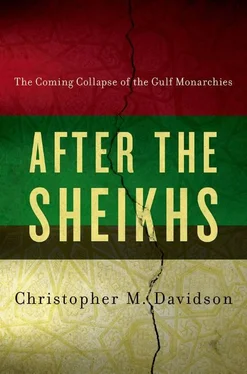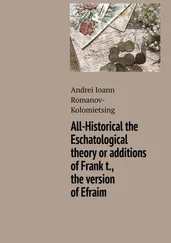The development of the UAE’s hydrocarbon industry is a little more complex to understand, much like its state formation. Given that most of the original concessions were signed before the UAE came into being, the two principal oil-producing emirates of Abu Dhabi and Dubai had already entered into agreements with different companies. In Abu Dhabi’s case, following the discovery of oil at Umm Shaif in 1958, the original British concessions were mostly renewed, with the granting of concessions to British Petroleum. Many other concessions were granted though, with Campagnie Française des Petroles, Royal Dutch Shell, Exxon-Mobil, Total, and the Japan Oil Development Company all winning sizeable stakes, most of which have been renewed. Since independence in 1971 a national oil company — the Abu Dhabi National Oil Company (ADNOC) — has always held controlling stakes in the various concessions, but these have never exceeded 60 per cent. [172] 116. Davidson (2005), pp. 94–95.
Similarly, Abu Dhabi’s gas industry has only been part-nationalised, with ADNOC holding stakes of 68 per cent and 70 per cent in the emirate’s two main gas concessions, while the remainder has been shared between British, American, and Japanese companies. [173] 117. Davidson (2009), chapter 4.
With oil discoveries in the early 1960s, Dubai followed a similar pattern to its neighbour with the government-owned Dubai Petroleum Company managing several international concessions from Britain, the US, Spain, France, and Germany. Production increased greatly in the 1980s before peaking in 1991. Since then, Dubai’s oil industry has been described as simply ‘ticking over’, with Abu Dhabi having accounted for over 90 per cent of the UAE’s oil exports over the past decade. [174] 118. Dubai’s share is now only 4 per cent, with the remainder being made up of minimal exports from Sharjah, Ra’s al-Khaimah, and Fujairah. Ajman and Umm al-Qawain do not have commercially exploitable oil reserves. Davidson (2009), chapter 4.
After oil was discovered in the western province of Oman in 1964, the Omani government pursued much the same model as Abu Dhabi and Dubai, with its wholly owned Petroleum Development Oman taking a 60 per cent stake in the industry and granting concessions to Royal Dutch Shell, Campagnie Française des Petroles, and Partex. Production increased greatly throughout the 1970s, and eventually reached its peak in 2000, at the same time that Oman opened its first major gas plant at the port of Sur.
Today, the Gulf monarchies produce a combined total of about 16.6 million barrels of crude oil per day, [175] 119. CIA World Factbook 2009, Economics overviews on Saudi Arabia, the UAE, Kuwait, Qatar, Oman, and Bahrain, 2007 and 2008 estimates. Author calculations for totals.
about 19 per cent of the global total, with the bulk being produced by Saudi Arabia, Kuwait, and the UAE — or more specifically Abu Dhabi. The six states also produce about 232 billion cubic metres of natural gas per year, [176] 120. Ibid.
about 8 per cent of the global total, with the bulk being produced by Qatar, Saudi Arabia, and the UAE. More importantly, perhaps, the Gulf monarchies account for 37 per cent of all known crude oil reserves and 25 per cent of all known natural gas reserves, [177] 121. Ibid.
with Saudi Arabia alone accounting for 25 per cent of global oil reserves [178] 122. British Petroleum Statistical Review, June 2008.
and with Qatar accounting for at least 15 per cent of global gas reserves. [179] 123. US Energy Information Administration (EIA). Qatar profile, 2009.
As discussed later in this book, an important disparity between the six states has thus emerged, with a hydrocarbon-rich group — namely Saudi Arabia, the UAE, Kuwait, and Qatar — all of which have at least a few decades of supply remaining, and with a much poorer group consisting of Oman and Bahrain, the latter of which now has to import most of its oil given the depletion of domestic reserves. [180] 124. CIA World Factbook . People and economics overviews of Japan, China, South Korea, Saudi Arabia, the UAE, Kuwait, Qatar, Oman, and Bahrain. Statistics from 2007–2008, with 2009 population estimates. Supplementary data from the International Monetary Fund, World Bank, and OECD country overviews, 2009.
Closely connected to the region’s hydrocarbon industry has been the channelling of surplus oil and gas revenues into long-term overseas investments by many Gulf monarchies. Conceived as a means of cushioning their domestic economies should the international oil industry falter, most of these sovereign wealth investments have been made through a handful of government owned authorities or companies. Today, their combined assets are thought to be in excess of $1.7 trillion, [181] 125. Kuwait News Agency , 15 January 2012. Combined assets are expected to reach $1.9 trillion in 2012.
and were generating some 10 per cent in interest per year prior to the 2008 credit crunch. [182] 126. Euromoney , 1 April 2006.
Although their operations remain fairly secretive, it is thought that they have historically favoured index-linked blue chip investments in the developed world along with mature western real estate. [183] 127. Davidson (2009), chapter 4.
Following the Dubai Ports crisis of 2006, when a government-owned Dubai company that had already purchased Britain’s Peninsula and Orient Steam Navigation Company unsuccessfully attempted to take over operations in several P&O managed ports in the US, most of the Gulf monarchies’ sovereign wealth funds have been careful to keep their stakes in western companies and multinationals relatively small in order to assuage fears that their investments are being used to gain political influence, and to avoid future xenophobic backlashes. As discussed later in this book, it appears that the funds have now branched out significantly into emerging markets and Pacific Asia, with Kuwaiti and Saudi Arabian funds in particular having poured billions of dollars into China. Soon it is likely that the value of these Pacific Asian investments will exceed those in Western Europe and North America. [184] 128. Davidson, Christopher M. The Persian Gulf and Pacific Asia: From Indifference to Interdependence (London: Hurst, 2011), chapter 5.
By far the largest of the funds is the Abu Dhabi Investment Authority (ADIA). Founded in 1976, it had accumulated $100 billion in overseas assets by the mid-1990s [185] 129. Van der Meulen, Hendrik, ‘The Role of Tribal and Kinship Ties in the Politics of the United Arab Emirates’ (PhD thesis. The Fletcher School of Law and Diplomacy, 1997), p. 93.
and about $360 billion by 2005. [186] 130. Davidson (2009), chapter 4.
Now symbolically housed in the tallest building in Abu Dhabi, it was estimated that ADIA controlled nearly $900 billion in assets in early 2008 [187] 131. The Economist , 17 January 2008; Seznec, Jean-François. ‘The Gulf Sovereign Wealth Funds: Myths and Reality’, Middle East Policy , Vol. 15, No. 2, 2008, pp. 97, 101. ADIA was believed to have had $875 billion in assets according to Deutsche Bank. However, Seznec believes the figure to be much lower. But he may have placed insufficient weight on ADIA’s history of investments in emerging markets.
and now it probably has about $600 billion following some losses, especially in the US. [188] 132. CIA World Factbook . People and economics overviews of Japan, China, South Korea, Saudi Arabia, the UAE, Kuwait, Qatar, Oman, and Bahrain. Statistics from 2007–2008, with 2009 population estimates. Supplementary data from the International Monetary Fund, World Bank, and OECD country overviews, 2009.
The second largest and the eldest of the region’s funds is Saudi Arabia’s SAMA Foreign Holdings. Founded in 1960, it now holds over $400 billion in assets. The Kuwait Investment Authority (KIA), founded in 1963, was for many years the largest of the funds, but after the 1990 Iraqi invasion of Kuwait and the subsequent costly rebuilding programme a number of its assets were sold. Nevertheless it still stands at over $200 billion, making it the region’s third largest fund.
Читать дальше












